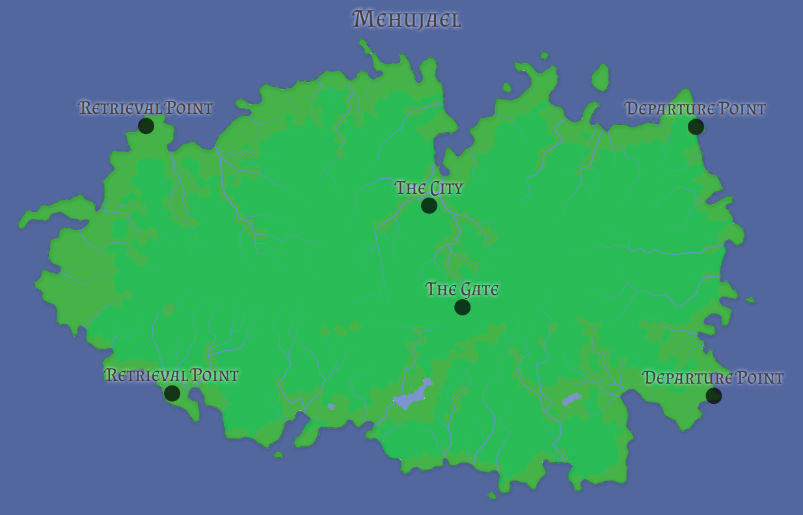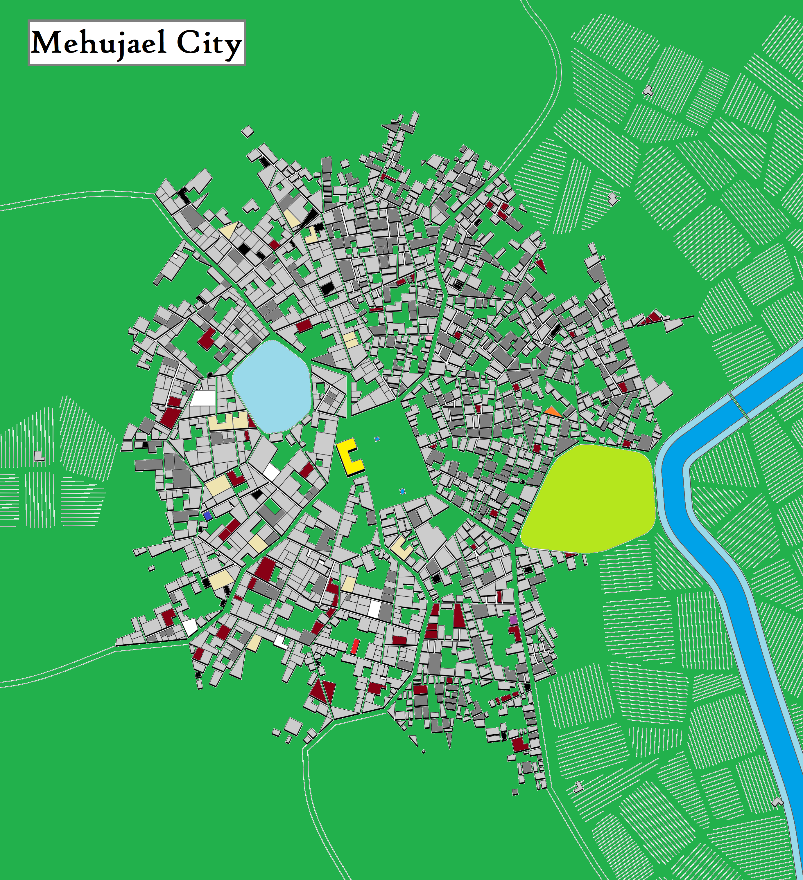Mehujael (cradle)
30 miles wide, average above surface 338 ft
Geography
Mehujael is distinct for its low altitude. While most islands hover thousands of feet above the lowlands, Mehujael's circuit frequently brings it within a few hundred feet of the world's surface. Mehujael's longest axis is only about 30 miles long. Most of its population is clustered into a single central city of a few tens of thousands. The outlying areas are lightly populated farmland, rolling hills, and gentle forests. The island is largely self-sufficient in terms of basic necessities but relies on outside trade for luxury goods and specialty items. Some inhabitants of Mehujael claim that the island is getting closer and closer to the surface with each passing year, and that it will eventually crash into the lowlands. Most people dismiss them as cranks and crackpots.

People and Culture
Native Mehujaelites have fairer complexions than most other islands.
Mehujaelites take advantage of their proximity to the ground to gather resources in the lowlands. This practice of "dropping" largely dominates the island's culture, politics, and economy. The majority of islanders are not droppers, but everyone has at least one family member who is. Therefore, they take pride in their Island's distinction, holding that life is short and one should live it to the fullest. Any excuse for a festival or holiday is a good one. Most people wear simple garments of flax (grown on the island), supplemented with fur and feathers from the lands below. Marks of status include the teeth, claws, or horns of fearsome surface creatures slain or scavenged by drop-teams.
The islanders are not a religious people, espousing a simple belief in rebirth and a reverence for ancestors. Druids are more common than clerics or paladins, but all claim to draw their power from both the Islands and the lowlands. A channler using healing or "safer" magic might draw from the Islands, while destructive or "risky" magic draws power from the land below.
Mehujaelites claim that humans first appeared on the world's surface, and because Mehujael was closest to that surface, it was the first island populated. Humanity then went on to spread to the other Islands from there. There is little hard evidence to support this claim.
Drops and Droppers
A typical drop consists of one or more teams descending from the leading edge of the island to the land below. As Mehujael passes over them, they forage, gather, and hunt in its shadow. When the island is about to leave them behind, they ascend to its trailing edge. Some drop-teams accomplish this via intricate systems of ropes, baskets, winches, and even parachutes or gliders. Teams with spellcasters may use simple magics such as Feather Fall and Levitate. Four large outposts and a number of smaller ones on the island perimeter send and receive drop-parties. Many have structures carved into the sides of the island for easier access, and all communicate with one another via a system of signal mirrors.
Because drop-teams are in and out in less than an hour, most drops are uneventful. Nevertheless, entire parties go missing often enough that dropping is a hazardous occupation. Less often, droppers return with tales of having survived monster attacks, of fight or (literal) flight. Dropping draws only the most hardened, reckless, or desperate men and women. Most droppers get a small arm tattoo for each drop they've survived; any dropper with more than twenty is considered a veteran. Nighttime drops are especially dangerous, warranting an extra-elaborate tattoo.
Droppers return with a variety of things, most notably herbs, fruit, and wood, none of which thrive on the Islands themselves. Drops also provide feathers, pelts, and the occasional small game. Specialty items and curiosities include the strong but flexible zeywood, crystals that glow with a soft light, and even small zoological specimens. Rarely, droppers find relics of some past civilization: shards of pottery, bits of metal, or stones painted with mysterious glyphs. Mehujael supports a small community of scholars who catalogue and study such findings.
Most droppers are "freelancers," but some receive sponsorship from merchants, scholars, or the Arcanists themselves. In addition to their usual duties, the Arcanists of Mehujael keep records on convenient, profitable, and unsafe drop-locations. This information is generally freely available; droppers survive through cooperation and knowledge-sharing, and Mehujael is relatively open and egalitarian. Occasionally, foreigners will commission a drop-team to obtain some particular flora, item, or information from the world below. However, outsiders who show up in hope of becoming droppers receive a chilly reception, at least until they're able to prove their worth.
Local Authority
Each year, islanders elect the Council of Three. The Arcanists choose one of their own. Non-droppers hold a straightforward vote. Droppers have a separate election, in which individuals receive one vote for each drop they've made in the past year. The Council makes its decisions via a simple majority vote.
Language
Muehjaelite language is rapid and flowing, despite the common fricatives. The written language is a scripted syllabary. Most Mehujaelites are at least somewhat literate, though full literacy is usually only found among scholars and merchants.
Traverton
The Mehujael Gate is in the forested interior of the Island among crumbled Ancient Ruins, surrounded by a sizable Traverton one day’s walk from the main city of a few tens of thousands. Outside the Traverton and main city most settlements are small villages and farms. Most visitors to the island are traders, though there is much traffic in the scholars of the surface and the things retrieved therefrom. It is a bucolic place to pass time between Gate openings, as the low altitude ensures consistently pleasant weather and the locals throwsmall but constant festivals and celebrations. However, other than exploring the many tourist markets for small surface relics there is not much else to see or do.
Mehujael's proximity to the lowlands (sometimes, it passes beside or between mountains, rather than above) also means that its inhabitants must be ready to repel the occasional airborne abomination. Professional sentries, armed with zeywood longbows, are stationed around the island's perimeter outposts, and along with obvious droppers can also occasionally be found in the Traverton serving as unofficial peacekeepers. The people also maintain a standing crossbow militia, less trained but more numerous than the professionals.
Mehujael City

- The golden C-shaped building towards the center is the council hall, housing the Council of Three and other bureaucratic functions.
- To the east is a large common area containing the North Well and South Well.
- North and west is a small lake which serves as a recreational area for the elite and as a store of water during the occasional drought.
- The northwestern road coming in is the most common avenue for returning drop-teams. There's a specialized market here; both merchants and scholars-in-residence tend to live in this area.
- The southern road leads to the Gate. The main city garrison is stationed here.
- There's another riverside common area to the east of the city, in light green.
- Farthest east, there's an old stone bridge over the river. It doesn't lead much of anywhere, but is quite scenic and is a popular rendezvous spot for trysting lovers or those making illicit deals.
- The northern road is the most common route by which drop-teams depart for their camps around the periphery of the island.
- The north and eastern portions of the city are populated by laborers and the less-affluent. Most of the homes here are multi-story and multi-family, or house large extended families.
- The western quarter is home to the most influential and affluent.
- Daytime markets, inns, taverns, shops, and residences are scattered throughout the city